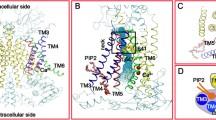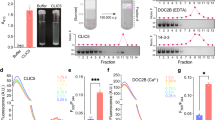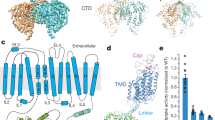Abstract
Calcium (Ca2+)-activated chloride channels are fundamental mediators in numerous physiological processes including transepithelial secretion, cardiac and neuronal excitation, sensory transduction, smooth muscle contraction and fertilization. Despite their physiological importance, their molecular identity has remained largely unknown. Here we show that transmembrane protein 16A (TMEM16A, which we also call anoctamin 1 (ANO1)) is a bona fide Ca2+-activated chloride channel that is activated by intracellular Ca2+ and Ca2+-mobilizing stimuli. With eight putative transmembrane domains and no apparent similarity to previously characterized channels, ANO1 defines a new family of ionic channels. The biophysical properties as well as the pharmacological profile of ANO1 are in full agreement with native Ca2+-activated chloride currents. ANO1 is expressed in various secretory epithelia, the retina and sensory neurons. Furthermore, knockdown of mouse Ano1 markedly reduced native Ca2+-activated chloride currents as well as saliva production in mice. We conclude that ANO1 is a candidate Ca2+-activated chloride channel that mediates receptor-activated chloride currents in diverse physiological processes.
This is a preview of subscription content, access via your institution
Access options
Subscribe to this journal
Receive 51 print issues and online access
$199.00 per year
only $3.90 per issue
Buy this article
- Purchase on Springer Link
- Instant access to full article PDF
Prices may be subject to local taxes which are calculated during checkout





Similar content being viewed by others
References
Hartzell, C., Putzier, I. & Arreola, J. Calcium-activated chloride channels. Annu. Rev. Physiol. 67, 719–758 (2005)
Frings, S., Reuter, D. & Kleene, S. J. Neuronal Ca2+-activated Cl- channels—homing in on an elusive channel species. Prog. Neurobiol. 60, 247–289 (2000)
Eggermont, J. Calcium-activated chloride channels: (un)known, (un)loved? Proc. Am. Thorac. Soc. 1, 22–27 (2004)
Large, W. A. & Wang, Q. Characteristics and physiological role of the Ca2+-activated Cl- conductance in smooth muscle. Am. J. Physiol. 271, C435–C454 (1996)
Nilius, B. & Droogmans, G. in Calcium-Activated Chloride Channels (ed. Fuller, C. M.) 327–344 (Academic, 2002)
Nilius, B. et al. Calcium-activated chloride channels in bovine pulmonary artery endothelial cells. J. Physiol. (Lond.) 498, 381–396 (1997)
Nilius, B. et al. Kinetic and pharmacological properties of the calcium-activated chloride-current in macrovascular endothelial cells. Cell Calcium 22, 53–63 (1997)
Sun, H., Tsunenari, T., Yau, K. W. & Nathans, J. The vitelliform macular dystrophy protein defines a new family of chloride channels. Proc. Natl Acad. Sci. USA 99, 4008–4013 (2002)
Huang, P. et al. Regulation of human CLC-3 channels by multifunctional Ca2+/calmodulin-dependent protein kinase. J. Biol. Chem. 276, 20093–20100 (2001)
Cunningham, S. A. et al. Cloning of an epithelial chloride channel from bovine trachea. J. Biol. Chem. 270, 31016–31026 (1995)
Nilius, B. & Droogmans, G. Amazing chloride channels: an overview. Acta Physiol. Scand. 177, 119–147 (2003)
Zholos, A. et al. Ca2+- and volume-sensitive chloride currents are differentially regulated by agonists and store-operated Ca2+ entry. J. Gen. Physiol. 125, 197–211 (2005)
Lee, M. G., Zeng, W. & Muallem, S. Characterization and localization of P2 receptors in rat submandibular gland acinar and duct cells. J. Biol. Chem. 272, 32951–32955 (1997)
Guibert, C., Marthan, R. & Savineau, J. P. Oscillatory Cl- current induced by angiotensin II in rat pulmonary arterial myocytes: Ca2+ dependence and physiological implication. Cell Calcium 21, 421–429 (1997)
Kuruma, A. & Hartzell, H. C. Bimodal control of a Ca2+-activated Cl- channel by different Ca2+ signals. J. Gen. Physiol. 115, 59–80 (2000)
Evans, M. G. & Marty, A. Calcium-dependent chloride currents in isolated cells from rat lacrimal glands. J. Physiol. (Lond.) 378, 437–460 (1986)
Hartzell, C. et al. Looking chloride channels straight in the eye: bestrophins, lipofuscinosis, and retinal degeneration. Physiology (Bethesda) 20, 292–302 (2005)
Arreola, J. & Melvin, J. E. A novel chloride conductance activated by extracellular ATP in mouse parotid acinar cells. J. Physiol. (Lond.) 547, 197–208 (2003)
Fuller, C. M. Ismailov, I. I., Keeton, D. A. & Benos, D. J. Phosphorylation and activation of a bovine tracheal anion channel by Ca2+/calmodulin-dependent protein kinase II. J. Biol. Chem. 269, 26642–26650 (1994)
Piper, A. S. & Large, W. A. Multiple conductance states of single Ca2+-activated Cl- channels in rabbit pulmonary artery smooth muscle cells. J. Physiol. (Lond.) 547, 181–196 (2003)
Arreola, J., Melvin, J. E. & Begenisich, T. Activation of calcium-dependent chloride channels in rat parotid acinar cells. J. Gen. Physiol. 108, 35–47 (1996)
Maricq, A. V. & Korenbrot, J. I. Calcium and calcium-dependent chloride currents generate action potentials in solitary cone photoreceptors. Neuron 1, 503–515 (1988)
Kenyon, J. L. & Scott, R. H. in Calcium-Activated Chloride Channels (ed. Fuller, C. M.) 135–166 (Academic, 2002)
Willis, W. D. & Coggeshall, R. E. Sensory Mechanisms of the Spinal Cord (eds Willis, W. D. & Coggeshall, R. E.) (Plenum, 2004)
Liu, X. et al. Attenuation of store-operated Ca2+ current impairs salivary gland fluid secretion in TRPC1-/- mice. Proc. Natl Acad. Sci. USA 104, 17542–17547 (2007)
He, X. et al. Polarized distribution of key membrane transport proteins in the rat submandibular gland. Pflugers Arch. 433, 260–268 (1997)
Gruber, A. D. et al. Genomic cloning, molecular characterization, and functional analysis of human CLCA1, the first human member of the family of Ca2+-activated Cl- channel proteins. Genomics 54, 200–214 (1998)
Elble, R. C. & Pauli, B. U. Tumor suppression by a proapoptotic calcium-activated chloride channel in mammary epithelium. J. Biol. Chem. 276, 40510–40517 (2001)
Gruber, A. D., Schreur, K. D., Ji, H. L., Fuller, C. M. & Pauli, B. U. Molecular cloning and transmembrane structure of hCLCA2 from human lung, trachea, and mammary gland. Am. J. Physiol. 276, C1261–C1270 (1999)
Greenwood, I. A., Miller, L. J., Ohya, S. & Horowitz, B. The large conductance potassium channel β-subunit can interact with and modulate the functional properties of a calcium-activated chloride channel, CLCA1. J. Biol. Chem. 277, 22119–22122 (2002)
Qu, Z., Fischmeister, R. & Hartzell, C. Mouse bestrophin-2 is a bona fide Cl- channel: identification of a residue important in anion binding and conduction. J. Gen. Physiol. 123, 327–340 (2004)
Hartzell, H. C., Qu, Z., Yu, K., Xiao, Q. & Chien, L. T. Molecular physiology of bestrophins: multifunctional membrane proteins linked to best disease and other retinopathies. Physiol. Rev. 88, 639–672 (2008)
Arreola, J. et al. Secretion and cell volume regulation by salivary acinar cells from mice lacking expression of the Clcn3 Cl- channel gene. J. Physiol. (Lond.) 545, 207–216 (2002)
Rosenfeld, M. A. & Collins, F. S. Gene therapy for cystic fibrosis. Chest 109, 241–252 (1996)
Schwiebert, E. M., Benos, D. J., Egan, M. E., Stutts, M. J. & Guggino, W. B. CFTR is a conductance regulator as well as a chloride channel. Physiol. Rev. 79, S145–S166 (1999)
Grubb, B. R., Vick, R. N. & Boucher, R. C. Hyperabsorption of Na+ and raised Ca2+-mediated Cl-secretion in nasal epithelia of CF mice. Am. J. Physiol. 266, C1478–C1483 (1994)
Boucher, R. C. et al. Chloride secretory response of cystic fibrosis human airway epithelia. Preservation of calcium but not protein kinase C- and A-dependent mechanisms. J. Clin. Invest. 84, 1424–1431 (1989)
Anderson, M. P. & Welsh, M. J. Calcium and cAMP activate different chloride channels in the apical membrane of normal and cystic fibrosis epithelia. Proc. Natl Acad. Sci. USA 88, 6003–6007 (1991)
Knowles, M. R., Clarke, L. L. & Boucher, R. C. Activation by extracellular nucleotides of chloride secretion in the airway epithelia of patients with cystic fibrosis. N. Engl. J. Med. 325, 533–538 (1991)
Huang, X., Godfrey, T. E., Gooding, W. E., McCarty, K. S. & Gollin, S. M. Comprehensive genome and transcriptome analysis of the 11q13 amplicon in human oral cancer and synteny to the 7F5 amplicon in murine oral carcinoma. Genes Chromosom. Cancer 45, 1058–1069 (2006)
Carles, A. et al. Head and neck squamous cell carcinoma transcriptome analysis by comprehensive validated differential display. Oncogene 25, 1821–1831 (2006)
Espinosa, I. et al. A novel monoclonal antibody against DOG1 is a sensitive and specific marker for gastrointestinal stromal tumors. Am. J. Surg. Pathol. 32, 210–218 (2008)
Acknowledgements
We thank R. MacKinnon and J. Wood for a review of themanuscript. We also thank B. Hille for his technical comment on ion permeability. This work was supported by Acceleration Research of MOEST/KOSEF of Korea. This work was also supported by the Brain Korea 21 Project and by the Wellcome Trust Foundation, UK (R.R.).
Author Contributions Y.D.Y. cloned the channel and its mutants and GPCRs. W.-S.S. worked on bioinformatics. Y.D.Y. recorded currents in oocytes. H.C., B.L. and M.H.T. recorded whole-cell currents. J.Y.K. recorded single-channel currents. J.L. and Y.C. worked on siRNA in vivo. B.-M.K. worked on western blot. R.R. measured Ca2+ and currents. S.P.P. measured electrolytes in saliva. Y.K.S. worked on immunohistochemistry. U.O. designed and supervised experiments, and wrote the manuscript.
Author information
Authors and Affiliations
Corresponding author
Supplementary information
Supplementary Information
The file contains Supplementary Text, Supplementary Figures 1-7 and Legends; Supplementary Tables 1-2 and Supplementary References. (PDF 7331 kb)
Rights and permissions
About this article
Cite this article
Yang, Y., Cho, H., Koo, J. et al. TMEM16A confers receptor-activated calcium-dependent chloride conductance. Nature 455, 1210–1215 (2008). https://doi.org/10.1038/nature07313
Received:
Accepted:
Published:
Issue Date:
DOI: https://doi.org/10.1038/nature07313
This article is cited by
-
Inhibition of TMEM16A improves cisplatin-induced acute kidney injury via preventing DRP1-mediated mitochondrial fission
Acta Pharmacologica Sinica (2023)
-
KCNE1 does not shift TMEM16A from a Ca2+ dependent to a voltage dependent Cl- channel and is not expressed in renal proximal tubule
Pflügers Archiv - European Journal of Physiology (2023)
-
Molecular logic of salt taste reception in special reference to transmembrane channel-like 4 (TMC4)
The Journal of Physiological Sciences (2022)
-
TMEM16A as a potential treatment target for head and neck cancer
Journal of Experimental & Clinical Cancer Research (2022)
-
Anoctamin 1 controls bone resorption by coupling Cl− channel activation with RANKL-RANK signaling transduction
Nature Communications (2022)
Comments
By submitting a comment you agree to abide by our Terms and Community Guidelines. If you find something abusive or that does not comply with our terms or guidelines please flag it as inappropriate.



